NVIDIA Announces Quadro P4000, P2000, P1000, P600, & P400 - Finishing the Quadro Pascal Refresh
by Ryan Smith on February 5, 2017 6:00 PM EST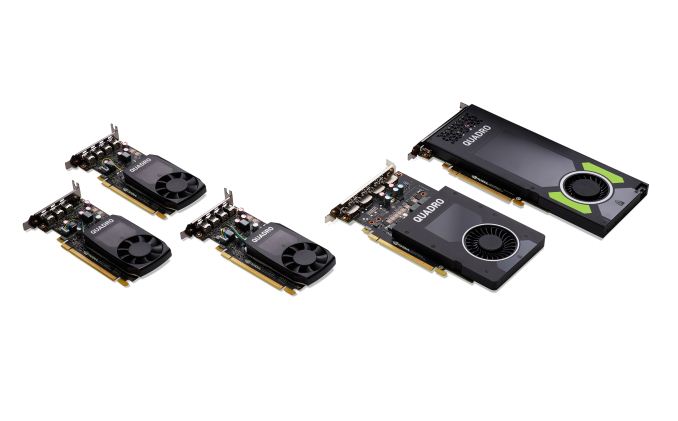
Alongside today’s big announcement of the GP100-powered Quadro GP100, NVIDIA is also announcing a sizable refresh to the rest of the Quadro family today at SOLIDWORKS World. Along with the Quadro GP100, altogether NVIDIA is announcing six new Quadro Pascal cards today, joining the two existing Pascal cards and finishing the rest of the Quadro family Pascal refresh.
As we’ve already covered the Pascal Quadro family feature set in some detail with the Quadro P6000 launch, I won’t go over it in great depth here. But at a high level Pascal and the cards based on it bring with them a few core improvements over previous generation Maxwell and Kepler cards. This includes much greater performance thanks to the smaller 16nm manufacturing process and resulting wider GPUs, single-port support for 5K@60Hz monitors thanks to DisplayPort 1.4, and Simultaneous Multi-Projection (SMP) for VR.
Moving on to the products then, the five cards covered here are being launched to replace their Maxwell M-series cards in the same segments. Over the years NVIDIA has worked out a distinct price/feature/TDP structure to their Quadro lineup, with this latest generation of cards meant to slot right into that.
| NVIDIA Quadro Specification Comparison (4000/2000) | ||||||
| Quadro P4000 | Quadro P2000 | Quadro M4000 | Quadro M2000 | |||
| CUDA Cores | 1792 | 1024 | 1664 | 768 | ||
| Boost Clock | ~1480MHz | ~1470MHz | 800MHz | 1180MHz | ||
| FP32 TFLOPS | 5.3 TFLOPS | 3.0 TFLOPS | 2.66 TFLOPS | 1.81 TFLOPS | ||
| Memory Bus Width | 256-bit | 160-bit | 256-bit | 128-bit | ||
| VRAM | 8GB | 5GB | 8GB | 4GB | ||
| FP64 | 1/32 | 1/32 | 1/32 | 1/32 | ||
| TDP | 105W | 75W | 120W | 75W | ||
| GPU | GP104 | GP106 | GM204 | GM206 | ||
| Architecture | Pascal | Pascal | Maxwell 2 | Maxwell 2 | ||
| Size | Single-Slot | Single-Slot | Single-Slot | Single-Slot | ||
| DisplayPort Outputs | 4 | 4 | 4 | 4 | ||
At the mid-range of the market are the Quadro P4000 and P2000. As the more powerful of the two, the Quadro P4000 is based on a cut-down GP104 GPU, the same GPU used in the Quadro P5000. However unlike the P5000, the P4000 has been cut down to size as a single-slot card. With respect to performance on paper it should deliver right around 2x the performance of the M4000, and it can do so with a TDP of 105W, 15W lower than its predecessor. It is also the lower-tier card that NVIDIA still classifies as VR ready; below the P4000 they don’t recommend their cards for VR development.
Meanwhile replacing the Quadro M2000 is the Quadro P2000. This card is in the same single-slot form factor as the P4000, but it drops down in power and performance, being built off of a GP106 GPU. Performance should be around 66% percent faster than its predecessor with the same 75W TDP. Surprisingly, NVIDIA didn’t opt to go with a fully-enabled 192-bit memory bus on this card; instead only 5 channels (160-bits) are enabled, which is also why it offers the more unusual memory capacity of 5GB.
Finally, both cards come with 4 full-size DisplayPort 1.4 connectors.
| NVIDIA Quadro Specification Comparison (1xxx) | ||||
| Quadro P1000 | Quadro K1200 | |||
| CUDA Cores | 640 | 512 | ||
| Boost Clock | ~1400MHz | 954MHz | ||
| FP32 TFLOPS | 1.8 TFLOPS | 0.98 TFLOPS | ||
| Memory Bus Width | 128-bit | 128-bit | ||
| VRAM | 4GB | 4GB | ||
| TDP | 47W | 45W | ||
| GPU | GP107 | GM107 | ||
| Architecture | Pascal | Maxwell 2 | ||
| Size | Low Profile | Low Profile | ||
| DisplayPort Outputs | 4 | 4 | ||
Still farther down the refreshed Quadro lineup we have NVIDIA’s low-profile cards, which cover the rest of the mid-range market and the entry-level market. All based around the GP107 GPU, these cards also serve to reintegrate the Quadro lineup into a single family; the cards these new Quadro products replace were sold as part of the Quadro K-series, and featured a mix of Kepler and Maxwell 1 GPUs.
Starting things off here we have the Quadro P1000. Replacing the GM107-based K1200, the P1000 is the most powerful of the low-profile Quadros. It uses a cut-down GP107 GPU clocked at around 1.4GHz. Overall performance on paper should be around 84% faster than the outgoing K1200, while TDP has drifted up just slightly from 45W to 47W. Meanwhile due to its size, NVIDIA has shifted to mini-DisplayPort connectors here. Interestingly, I’m told that these are latching ports, which isn’t standard for mini-DisplayPort but offers a more robust connection as a result.
| NVIDIA Quadro Specification Comparison (6xx/4xx) | ||||||
| Quadro P600 | Quadro P400 | Quadro K620 | Quadro K420 | |||
| CUDA Cores | 384 | 256 | 384 | 192 | ||
| Boost Clock | ~1430MHz | ~1170MHz | 1000MHz | 780MHz | ||
| FP32 TFLOPS | 1.1 TFLOPS | 0.6 TFLOPS | 0.76 TFLOPS | 0.3 TFLOPS | ||
| Memory Bus Width | 128-bit? | 128-bit? | 128-bit | 128-bit | ||
| VRAM | 2GB | 2GB | 2GB | 1GB | ||
| TDP | 40W | 30W | 45W | 41W | ||
| GPU | GP107 | GP107 | GM107 | GK107 | ||
| Architecture | Pascal | Pascal | Maxwell 1 | Kepler | ||
| Size | Low-Profile | Low-Profile | Low-Profile | Low-Profile | ||
| DisplayPort Outputs | 4x Mini | 3x Mini | 1x (+1 DVI) | 1x (+1 DVI) | ||
Rounding out the rest of the pack is the Quadro P600 and P400. The Quadro P600 is essentially a lower-performance version of the P1000. It drops down to 1.1 TFLOPS – around 45% faster than its predecessor – and retains the 4 mini-DisplayPort connectors. TDP on this part is 40W, down from 45W for the Quadro K620. Also of note here, the low-end Quadros are finally getting an upgrade to GDDR5, versus DDR3 that was found on their K-series counterparts.
Finally, bringing up the rear is the Quadro P400. This replaces the K420, which was the last Kepler-based part in the Quadro lineup. Performance here should more than double, considering both the vast improvement in architecture and clockspeeds. Meanwhile the P400’s TDP is 30W, versus 41W for the K420. Note that relative to the P600, the P400 loses a mini-DisplayPort; though this is still up from the 2 total ports on the K420.
Wrapping things up, as with the Quadro GP100, the rest of these new Quadro cards will start to arrive in March. NVIDIA hasn’t published formal prices for these cards, but we’re told that prices should be similar to the last-generation Quadro cards that they replace.



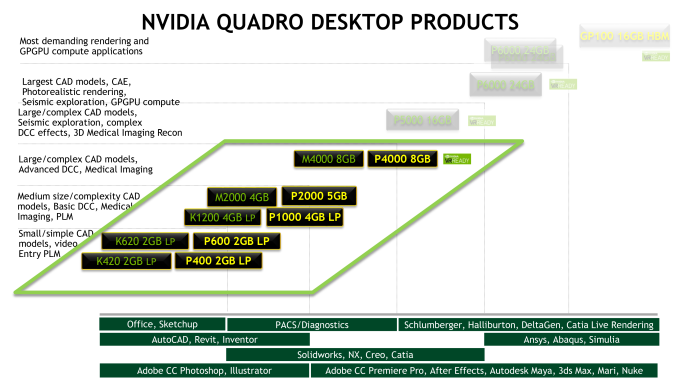
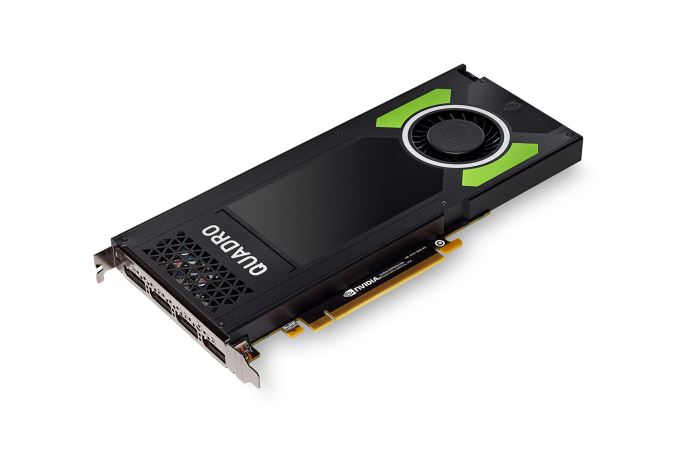
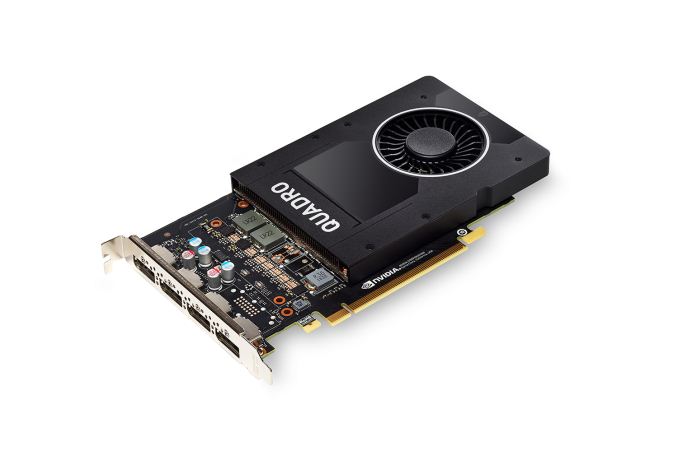
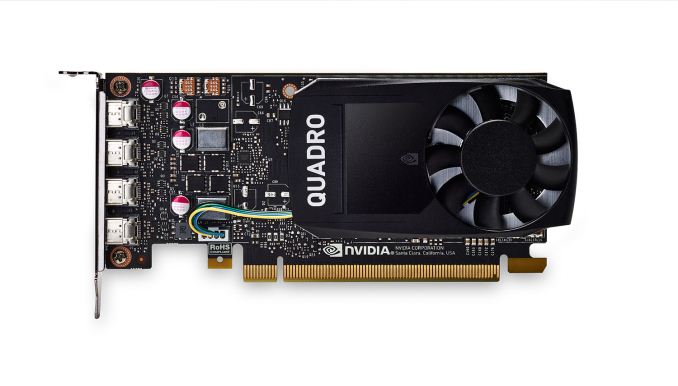
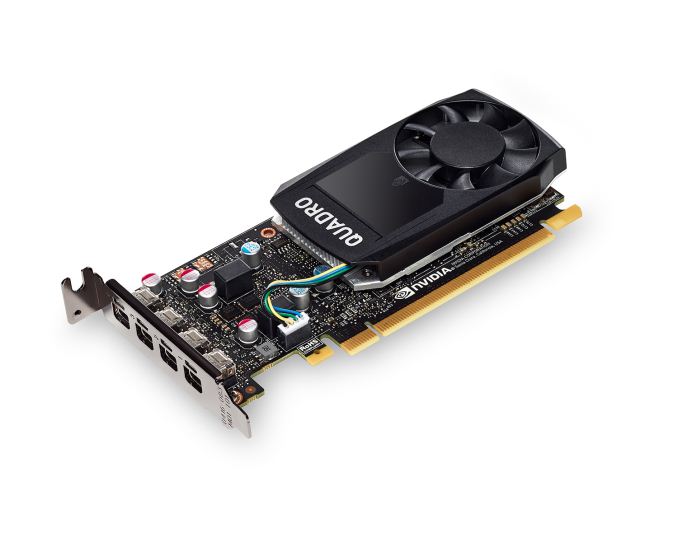

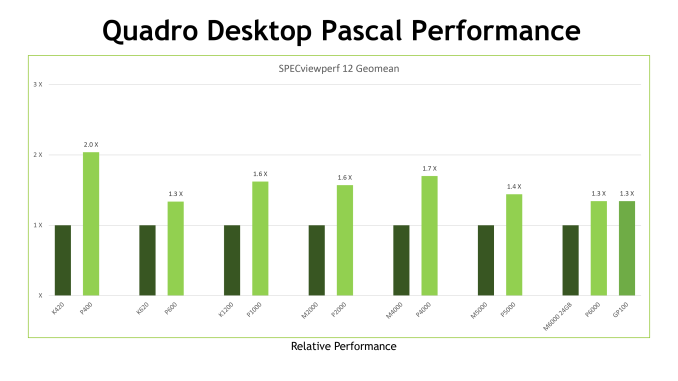








21 Comments
View All Comments
ImSpartacus - Monday, February 6, 2017 - link
If only CPUs could just scale up in both power consumption and compute resources every year...Ej24 - Monday, February 6, 2017 - link
Omg give me a p600 in a consumer card as a gtx 1040!! I'd love a half height single slot gpu from this generation! My low profile single slot HD 7750 is really showing its age.ImSpartacus - Monday, February 6, 2017 - link
Isn't there a single slot 460 by XFX?http://techreport.com/news/31028/xfx-rx-460-core-s...
I don't think you're going to get a reference single slot card any time soon.
Ej24 - Monday, February 6, 2017 - link
There is a single slot 460. Single slot but not low profile (half height). Also I don't care if its reference design or not, we need smaller cards to replace the ancient gt730.RBFL - Monday, February 6, 2017 - link
Like this ?https://www.zotac.com/us/product/graphics_card/zot...
BrokenCrayons - Monday, February 6, 2017 - link
That video card is full height and dual slot. I think the discussion is about half height single slot graphics cards. At the present time, the most powerful GPU available that meets those criteria is the GT 730 which really isn't much of a gaming card.RBFL - Monday, February 6, 2017 - link
Thanks, my bad. Having an i3 HP SFF machine I picked up on Black Friday I had hoped the fact that it only used one slot to hold it meant it was half height as well.Some of the two slot cards appear to have low profile alternative mounting plates. So all I need is one of those designs that only has say an HDMI and a DP connection and ditches the DVI. Apparently I am not alone in waiting for this Unicorn.
BrokenCrayons - Monday, February 6, 2017 - link
If all you need is one DP and one HDMI, and you can handle a dual slot cooler, then you might not need to wait long. AT ran a news article not long ago for a half height 1050 and 1050Ti from GALAX. When the article went online a couple days ago, there wasn't availability on it, but I'm almost certain there's more than one company selling half height 1050s, just not outfitted with single slot coolers. Anyway, the GALAX card still has a DVI port, but it otherwise might fit your needs.http://www.anandtech.com/show/11094/galax-adds-low...
Ej24 - Tuesday, February 7, 2017 - link
Actually the Radeon HD 7750 aka R7 250E is still the best single slot, half height card. Hard to find many anymore.BrokenCrayons - Monday, February 6, 2017 - link
The cost for the performance is probably going to be pretty stupid versus a consumer card but the P600 and P400 are almost enticing enough to lure me back into a desktop gaming box. Thus far, they're the only GPUs with reasonable TDP released this generation and the half height & single slot form factor is nice too. I'm so sick of seeing dual slot graphics cards.